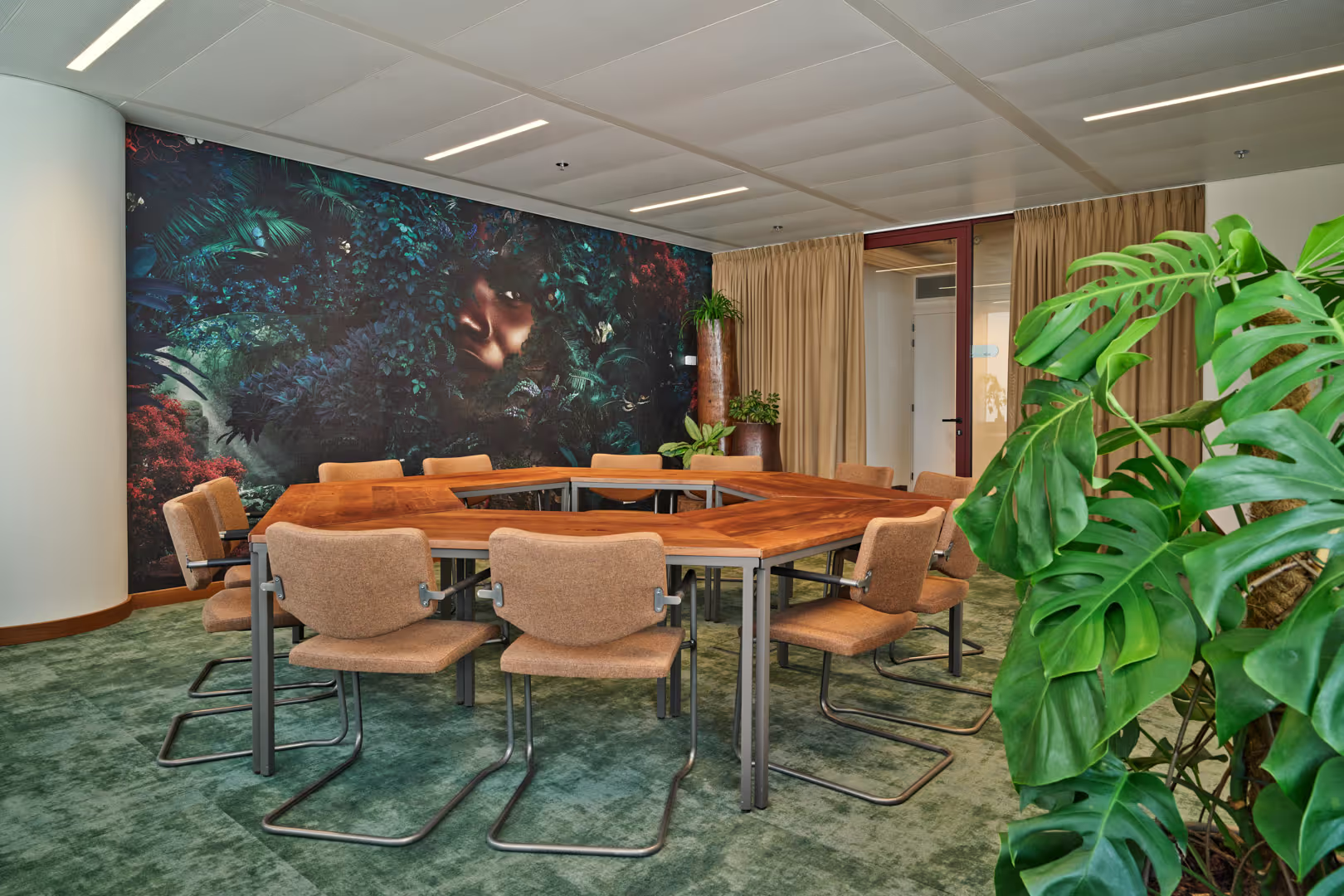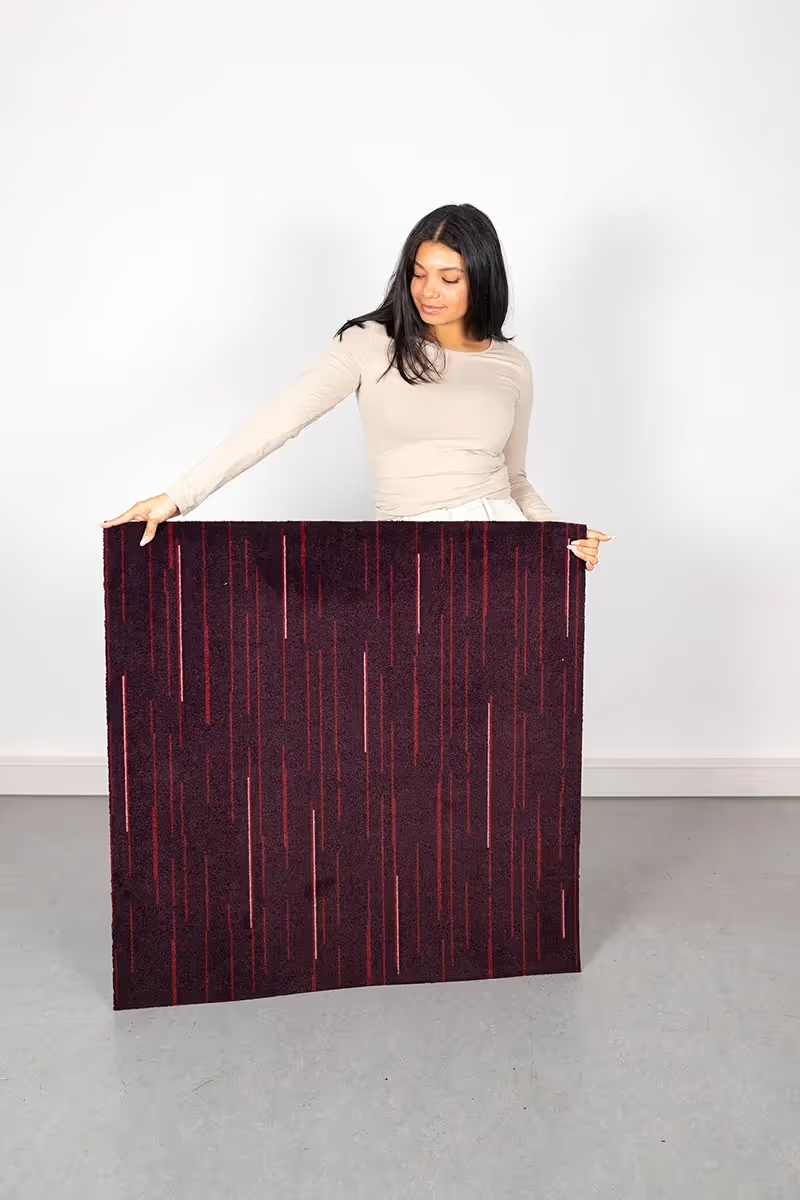Botanical
This carpet tile lets the professional interior effortlessly breathe the atmosphere of a boutique hotel. Luxurious, inviting, intimate and special. The secret lies in the rich velvet look and feel. The result of an exciting interplay between tone-on-tone tones with a subtle touch effect. Could it be even more exciting? Then combine it with the XL45. The deep, intense colors complete the picture. The color palette contains no less than 18 colors: from warm earth tones and ochre to deep blue and green tones. Also available in a wide carpet.
Also in our collection
Carpettile
with the same colors
Reuse before recycling
From the start, sustainability has been an important pillar alongside design. Recycling products is a great step in the right direction to use our raw materials sustainably. We are therefore very much in favour of it. But there are still so many steps before recycling. That is why we believe in extending the lifespan. Keep a carpet in circulation for as long as possible before it is finally recycled and the raw materials can be reused.
Because why disassemble a high-quality product after a few years to make something different out of it? We first give the product a long, valuable life before we disassemble it. What Donkersloot rests on. We believe in the circular economy. That is not a dream for the future, but the new reality. In which we complete the circle, preserve raw materials and reuse products. This is about value creation and preservation of value.
Circularity
Sustainability plays a role in all the choices we make, both at the product and value chain level and strategy.check out our products that deserve a second chance
check out our products that deserve a second chanceInnovation
We designed a “No waste rug” from material left over after production. An important step in our journey to become a fully zero-waste brand. The pattern can be composed of different colors, depending on what production waste is currently available.
Want to know more? Then please contact us.
Towards circularity
Since its inception, sustainability has been, in addition to design, an important pillar on which Donkersloot rests. We believe in the circular economy. That is not a dream for the future, but the new reality. In which we complete the circle, preserve raw materials and reuse products. This is about value creation and preservation of value.
Circularity
Sustainability plays a role in all the choices we make, both at the product and value chain level and strategy.
Innovation
We work with our chain partners to find new solutions so that our carpets are better reused and also easier to disassemble.

FAQs
Find answers to the most frequently asked questions about our products.
Met tegeltapijt, breed tapijt en karpetten voeg je in een handomdraai warmte, sfeer en creativiteit toe aan ieder interieur. Maar tapijt is niet alleen mooi en zacht, het heeft ook een geluiddempende werking. Lees alles over de voordelen van tapijt
Carpet tiles are generally cut randomly from a larger pattern. As a result, the design is cut off at the tile edge and you will often see the tile frames in the floor. With one design, this is more noticeable than the other and can be annoying.
That's why we have cut tiles on report. The designs on these tiles are designed to fit on all sides. With this tile or series of tiles, the design flows almost seamlessly from one tile to the other. In this way, sophisticated patterns can be created and the tile edges are almost invisible. It is therefore also possible to create a wall-to-wall floor image with tile carpet.
When talking about the circular economy, it is often about recycling. But there are actually different types of strategies for achieving circularity, and eco-design and reuse are higher on the ladder than recycling in the waste hierarchy.
So circularity is not just about making products recyclable and then recycling them. Balancing what goes into your product and saving resources at that stage (eco-design) and extending the lifespan are important strategies for keeping raw materials in circulation for as long as possible. That is why, in our design, for example, we reconsider which materials we choose. How can you reduce your environmental impact by using, for example, secondary raw materials instead of primary raw materials.
With the Modular Dimension, for example, we are focusing on extending the lifespan. In a creatively flexible way. Because 20% of the total floor area is actually only used intensively. This means that 80% is easy to use again. In this way, you can ensure that raw materials stay in circulation longer and that there is less environmental pressure.
Finally, we also focus on circularity in the sense that raw materials are reprocessed into raw materials — whether that is recycling mechanically or chemically.
The transition to the circular economy is not that simple. There are many parties involved, each of which must play a specific role in order to ultimately achieve circularity. Circularity is really a collaborative effort. And to be viable as a team, information must be shared between the parties.
In order to do that efficiently, it is important to have a digital passport, also known as Digital Twin mentioned, where all important information about the materials and the product is stored. And where new information can also be added during the life cycle.
The European Commission has the ambition to also use a digital revolution for the circular economy. And they call that”Twin Transition”. So in order to achieve that circular economy, we will also need to have a digital reflection of the materials that are in circulation. This is also supported by laws and regulations that will come in the coming years. In fact, the circular economy cannot be realized without a digital transition.
Since its inception, it has been a conscious choice for Donkersloot not to own machines. A conscious choice that makes a world of difference. Flexibility and top results, that's what it's all about. For us, it is not the machine or production method that is leading, but the ultimate end result. That is our starting point; that's why we look for the most suitable production method and the best materials.
That's why we develop our products together with various European partners. Carpets have been manufactured in Europe for centuries, even before the industrial revolution and the birth of the chemical industry. Because of this rich history of carpet making, a great deal of valuable knowledge is available. It is therefore all the more important that craftsmanship continues to exist and that the industry in Europe also has a future.
In our path to sustainability, knowledge of this craft is invaluable. In addition, we challenge our partners to combine their craftsmanship with new materials, production methods and technologies. This is how we help our value chain innovate towards a Circular Economy.
There are various ways to reduce environmental pressure. The use of secondary raw materials is therefore very important. For example, we integrated Econyl yarn into a large part of our rugs. It is a recycled polyamide, which has the potential to be recycled indefinitely without loss of quality. In addition, the Modular Dimension's backing is made entirely of recycled textile. And our BT40 circular wall-to-wall carpet, XL40 tile carpet and various rugs can be disassembled down to the last thread and recyclable time after time.
For example, creativity and sustainability go hand in hand for a sophisticated statement in design and a contribution to a better future.

















